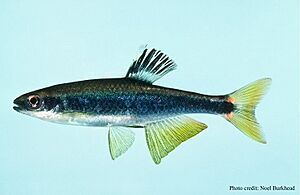Sailfin shiner facts for kids
Quick facts for kids Sailfin shiner |
|
|---|---|
 |
|
| Conservation status | |
| Scientific classification | |
| Synonyms | |
|
The sailfin shiner (Pteronotropis hypselopterus) is a small, colorful fish. It's a type of cyprinid fish, which means it's related to minnows and carps. This fish is special because it's only found in the southeastern United States.
About the Sailfin Shiner
What Does It Look Like?
The sailfin shiner has a body that is tall and flat, like it's been squeezed. Its tail fin has a narrow base. This fish also has a special line along its side, called a lateral line, which curves downwards. It can grow up to about 7 centimeters (2.75 inches) long.
Its upper body is usually pink-brown or olive green. The bottom half is white or light pink. A dark brown stripe runs from its head to its dorsal fin. There's also a shiny, steel-blue stripe along its side. This blue stripe has a thin pink or red line just above it.
At the base of its tail fin, there are small red spots. One is on the top and one on the bottom. Right in the middle of the tail fin's base, there's a black spot. The dorsal fin has a dark band in the middle. All the other fins are yellow or light orange. The dorsal and anal fins are shaped almost like triangles, much like sails on a boat. This is how the fish got its name, "sailfin" shiner! When male fish are ready to breed, the edges of their dorsal fins turn light orange.
Where Does It Live?
You can find the sailfin shiner in rivers and streams along the Gulf Coast. This includes areas from Alabama all the way to Florida. They also live in the Mobile Basin.
These fish like to live in creeks and small rivers. They prefer areas with sandy or clay bottoms. You can often spot them hiding around underwater plants or fallen branches.
How Does It Grow?
The life of a sailfin shiner starts as a tiny embryo. As it grows, special "cement glands" form. When it's a very young larva, it doesn't eat yet. It uses a sticky "glue" from these glands to attach itself. During this time, its gills, mouth, and gut start to form. Its yolk sac, which provides food, becomes smaller.
When the fish is ready to swim up, it stops making glue. Its swim bladder, which helps it float, fills with air. At this stage, the fish floats in the water. The yolk is almost gone, and it starts to form another part of its swim bladder. After it begins to eat on its own, its other fins, like the median and pelvic fins, grow. Its swim bladder fully inflates, allowing it to swim freely.


